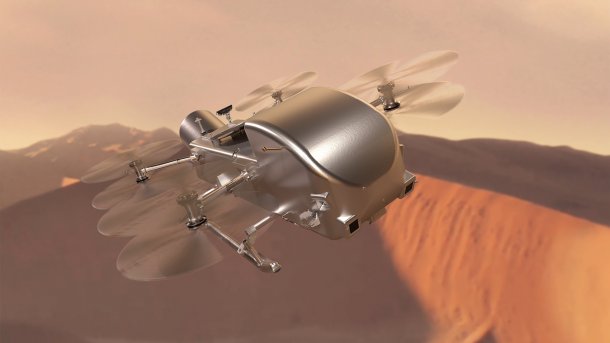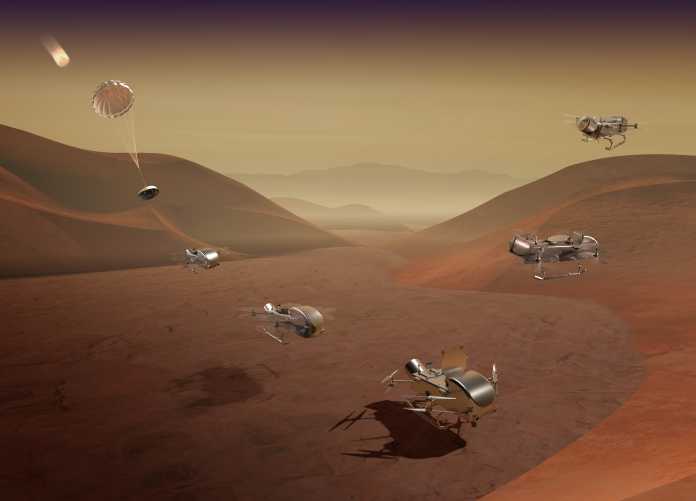NASA confirms Dragonfly mission to explore Saturn's moon Titan in 2034
The ambitious NASA Dragonfly mission had been quiet for a long time, but now the plans have been confirmed. The drone is set to fly over Titan from 2034.

This is what Dragonfly should look like
(Bild: NASA/Johns Hopkins APL/Steve Gribben)
NASA has confirmed the "Dragonfly" drone mission to Saturn's moon Titan. This means that the design can now be finalized and construction of the device can begin. The US space agency announced this and added that time lost in the meantime will be made up for by launching with a more powerful rocket. Although the mission will not be launched until 2028 instead of 2026, the drone will still fly over the moon as planned in 2034. There it will examine various promising locations from above and search for traces of prebiotic chemical processes that Titan has in common with those that existed on Earth before the emergence of life.
(Bild: NASA/Johns Hopkins APL/Steve Gribben)
Arrival should not be delayed
As NASA summarizes, the plans for the drone mission passed their preliminary test a year ago. An update on the planned budget and timeline was then required. Both were then confirmed in the autumn. With US President Joe Biden's budget plan, it is now possible to proceed with the project, for which a total of 3.35 billion US dollars has now been earmarked – twice as much as originally planned. The mission is now scheduled to start in July 2028, with delays caused not only by cost-cutting constraints but also by difficulties caused by the coronavirus pandemic. However, NASA is confident that these will be made up for.
Dragonfly ("dragonfly") is to be equipped with eight rotors and will explore Titan for two years. The device should be able to cover dozens of kilometers in one hour during a flight, and one such flight should be possible every day on Titan – which will last 16 Earth days. The device will not be able to rely on solar energy for this, but will function with electricity from a radionuclide battery. During the entire mission, the drone will travel hundreds of kilometers from the landing site. That would be much further than any rover in the history of space travel. The drone will carry out the majority of its measurements and analyses on the surface; the flights will only take it to new locations. NASA has already gained experience with this on Mars.
Particularly interesting for science
Titan is the largest moon of the ringed planet Saturn and is only smaller in the solar system than Jupiter's moon Ganymede. Although temperatures of minus 180 degrees Celsius prevail on its surface, its dense atmosphere makes it one of the most Earth-like environments in the solar system. Titan is the only known celestial body apart from Earth to have liquids on its surface. However, the discovered lakes do not consist of water, but of liquid hydrocarbons such as methane and ethane. They form a cycle similar to that of water on Earth. There is also evidence of an ocean of water beneath the surface. So there are potentially life-friendly environments.
Titanmission Dragonfly der NASA (7 Bilder)

The Saturn probe Cassini gave usa first impression of Titan's surface from orbit, and Huygens also landed there in 2005. It sent images directly from the surface for the first time. Just three years ago, a research group also determined that impacts from large meteorites or asteroids on the moon Titan have created "almost optimal" habitable ecosystems or will do so again in the future. According to this, such impacts could have ensured that organic compounds on the surface and liquid water from the subsurface were mixed in a localized habitable zone. This could have existed long enough to allow the emergence of life.
(mho)